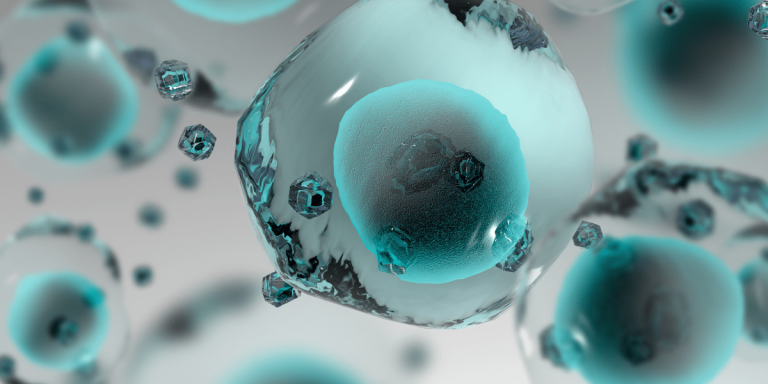
“It is amazing we are able to use heat and magnetism to treat cancer. The same process may apply to other disease processes. ”
It has been said of traditional cancer treatments that “the cure is worse than the disease,” but this may not be the case in the future. Nanotechnology is opening new avenues of cancer treatment that have minimal, if any, side effects.
Dr. Prem Vaishnava, professor of Applied Physics at Kettering University, is working with Wayne State University’s Department of Radiation Oncology, Eugene Applebaum College of Pharmacy and Department of Physics to develop novel cancer treatments that utilize magnetic hyperthermia therapy to eliminate cancer cells without damaging surrounding healthy tissue.
According to the National Cancer Institute, “Hyperthermia, also called thermal therapy or thermotherapy, is a type of cancer treatment in which body tissue is exposed to high temperatures (up to 113°F). Research has shown that high temperatures can damage and kill cancer cells, usually with minimal injury to normal tissues. By killing cancer cells and damaging proteins and structures within those cells, hyperthermia may shrink tumors.”
Hyperthermia can be used to treat regions varying in size from microscopic tumors to the entire body. To treat larger tumors, microwave, laser or ultrasound energies have been used to produce heat for hyperthermia treatment. For whole body hyperthermia treatment, a thermal chamber can be used to raise the patient’s body temperature to 42 degree Celsius.
Vaishnava and collaborators at Wayne State University have been utilizing magnetic nanoparticles between 10 and 20 nm in diameter to deliver targeted hyperthermia to maximize the benefits and damage less healthy tissue.
In this technique, ferrofluid-containing superparamagnetic iron oxide nanoparticles, are injected directly into tumors. An alternating magnetic field is then applied and the nanoparticles respond to this field by generating heat to destroy the cancer cells.
The group has been investigating different methods of functionalizing the nanoparticles to allow for the most efficient uptake into tumor cells. Vaishnava’s role in the Wayne State-sponsored research is to investigate the complex interplay between a tumor’s geometry and the delivery of magnetic hyperthermia.
“It is not required to heat a tumor much to achieve the desired result,” he said. “Temperatures between 42 -45 degrees Celsius are sufficient for the localized hyperthermia treatment. Our method will heat just the tumor, not the entire body. Once heated to this temperature the cancer cells are killed,” Vaishnava added.
“It appears to be a simple technique to treat cancer,” he said, however, there are many challenges that need to be addressed before this treatment could become more routinely available. First, it is difficult to determine the temperature at the tumor site. Second, having the nanoparticles target only the cancer cells and not healthy cells and third, making sure that the residual nanoparticles pose no future health risk to the patient” he said.
European radiation oncologists have been using this technique for some time now, according to Vaishnava, and magnetic hyperthermia is currently in Phase III of clinical trials in the United States.
The procedure consists of 30-minute treatments once a day for approximately seven days. “However, at present, oncologists are using hyperthermia treatment in combination with radiotherapy and chemotherapy. Hyperthermia not only kills cancer cells it makes cancer cells vulnerable to other treatments ,” said Vaishnava.
He further explained, “Our approach to treat cancer involves two steps. First, we look at the geometry of the tumor. Then, depending on the geometry of the tumor we have to change the power of the magnetic field and its frequency to eliminate the entire tumor.”
Secondly, the biocompatible iron oxide nanoparticles have to enter the cancer cells to work, which means researchers have to find a way to facilitate ease and efficiency of entry. This is accomplished by coating the nano-particles to achieve functionalization for preparation for easier entry into the cancer cell. “Once the nano-particles are inside the cancer cells, heating and cytotoxicity become easier and more predictable.” said Vaishnava.
Another application of hyperthermia relates to transfection. Transfection is one of the techniques by which damaged DNA molecules could be replaced by healthy DNA from a stem cell. In one of Vaishnava’s on-going projects, he and colleagues are investigating the effect of hyperthermia to increase the efficiency of the uptake of DNA by the cells. Hyperthermia increases the efficiency of the DNA transfer, according to Vaishnava.
“The key is heat,” said Vaishnava, “It is amazing we are able to use heat and magnetism to treat cancer. The same process may apply to other disease processes.”
Vaishnava presented a paper on his work at the May 2011 Annual European Society of Hyperthermia Oncology in Aarhus, Denmark.
Contact:
Dawn Hibbard
810.762.9865
dhibbard@kettering.edu